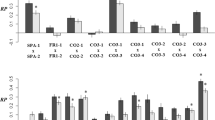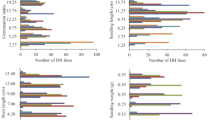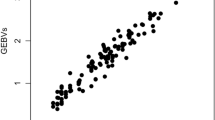Abstract
SEVERAL workers1–3 have recently pointed out the importance of the stabilizing type of natural selection, in which the intermediate phenotype has an adaptive advantage over the deviants from such a centrally located norm, thus resulting in a rather stable population mean and a continually diminishing population variance. Robertson4 has analysed the theoretical implications of two different models of stabilizing selection: the intermediate optimum model of Wright5, where the more fit individuals are phenotypically intermediate, and the homeostatic model of Lerner6, in which the favoured individuals are more fit since they are heterozygotes. The latter model involves true overdominance at one or more loci governing fitness or its various components. Hence, it would be of interest to investigate an actual example of stabilizing form of selection for its fit to one or the other model. The present communication summarizes evidence for stabilizing selection for heading time (recorded as the number of days before the first spike comes out of the flag leaf) in a bulk-hybrid population of barley that was derived from a composite cross and propagated over 18 generations under natural self-fertilization without conscious selection, and it further provides some information on the discriminating choice between the two models.
This is a preview of subscription content, access via your institution
Access options
Subscribe to this journal
Receive 51 print issues and online access
$199.00 per year
only $3.90 per issue
Buy this article
- Purchase on Springer Link
- Instant access to full article PDF
Prices may be subject to local taxes which are calculated during checkout
Similar content being viewed by others
References
Schmalhausen, I. I., Factors of Evolution, 1327 (Blakiston, Philadelphia, 1949).
Mather, K., Cold Spring Harbor, Symp. Quant. Biol., 20, 158 (1955).
Waddington, C. H., The Strategy of Genes (1958).
Robertson, A., J. Genetics, 54, 236 (1956).
Wright, S., J. Genetics, 30, 243 (1935).
Lerner, I. M., Genetic Homeostasis, 133 (John Wiley and Sons, New York, 1954).
Wright, S., Ann. Eugenics, 15, 323 (1951).
Jain, S. K., and Allard, R. W., Proc. U.S. Nat. Acad. Sci., 46, 1371 (1960).
Author information
Authors and Affiliations
Rights and permissions
About this article
Cite this article
JAIN, S. Stabilizing Selection for Heading Time in a Bulk-Hybrid Population of Barley. Nature 191, 1123–1124 (1961). https://doi.org/10.1038/1911123b0
Issue Date:
DOI: https://doi.org/10.1038/1911123b0
This article is cited by
-
Modal selection in upland cotton
Heredity (1964)
Comments
By submitting a comment you agree to abide by our Terms and Community Guidelines. If you find something abusive or that does not comply with our terms or guidelines please flag it as inappropriate.



